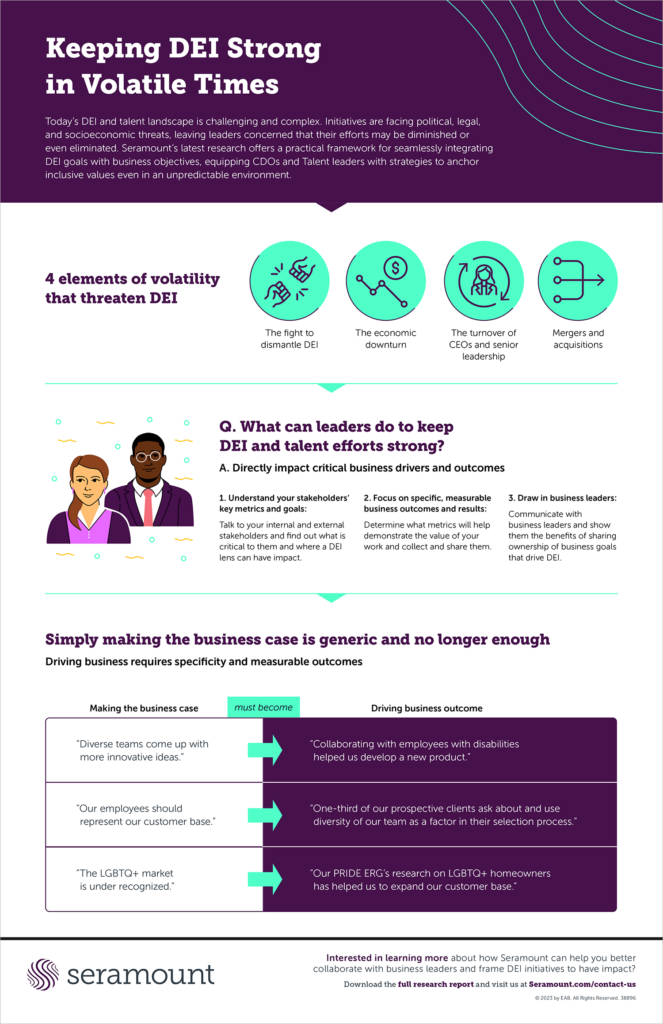Just three years after the killing of George Floyd set off a slew of corporate pledges in the United States to prioritize diversity, equity, and inclusion (DEI), especially around representational goals, organizational programming around DEI is facing legal and political threats. Some companies are doubling down on their DEI efforts while most are adopting a wait-and-see attitude. Some Chief Diversity Officers (CDOs) and Talent leaders are nervous that their efforts may be diminished or even eradicated. As one CDO interviewed for this project said: “DEI has become central to a lot of rhetorical attacks. It seems like a race to the bottom on portraying DEI as the enemy rather than the solution.”
And political pushback is only one of the current threats to DEI. CDOs and Talent leaders also operate within an environment of global economic uncertainty, where their work can be marginalized. In the absence of a clear connection to business outcomes, DEI work is particularly vulnerable to economic and sociocultural upheaval.
In an effort to understand the major obstacles that DEI and Talent leaders face in uncertain times and demonstrate solutions and proven results to the members of our CDO Collaborative, Seramount embarked on a new research study, “Keeping DEI Strong in Volatile Times.”
Research Methodology
In addition to reviewing best practices from about 100 organizations across sectors and geographies, Seramount’s research team reviewed more than 200 articles culled from academic journals, industry trade publications, and general news sources and conducted more than 30 interviews with CDOs, subject-matter experts, and other corporate leaders.
Why This Study?
When this research started in December 2022, the focus was on the impact of the projected economic downturn on DEI resources. While that has played out, especially in the tech sector, it has become apparent that the threats to DEI are larger and more complicated. Today’s DEI teams and their programming are vulnerable to four unique elements of volatility:
- Economic downturns
- The fight to dismantle DEI
- New organizational leadership that may not value DEI
- Changing corporate values and priorities in mergers and acquisitions
For all four elements, there is a clear solution, as this research demonstrates, including:
- Link DEI to urgent business outcomes in order to safeguard the DEI team’s work and bolster DEI’s value to the company. Tie DEI efforts to high-priority organizational business objectives to mitigate cutbacks and protect your DEI efforts from being shoved aside. Learn how to go about making strong connections to business outcomes.
- Iterate how fulfilling the mission of creating a diverse, equitable, and inclusive workplace works in tandem with increasing profits.
Crucially, this study demonstrates the importance of moving beyond the conventional understanding of “the business case” for diversity. The traditional DEI business case relies on broad statements about population demographics, such as “The United States will be majority-minority soon” or “The LGBTQ+ population is growing with every generation.” In its more advanced forms, the business case may even point to research demonstrating that more diverse teams are more innovative and more productive. All of these statements are true, broadly speaking. But just because they’re true doesn’t mean they’re sufficient.
In today’s turbulent and ever-changing world, generalized assertions that are assumed to be applicable to all businesses are no longer enough. The new business case requires making the connection between DEI goals and the work of a specific organization. To sustain their efforts, contemporary CDOs and Talent leaders must navigate dual roles as DEI change agents and business leaders. This report will show you how to help your business succeed and how to fulfill your DEI mission at the same time—and in doing so, how to protect DEI work from all elements of volatility.
Conclusion
Today’s CDO and Talent leaders face what can feel like a morass of challenges. From external forces such as political attacks on DEI or an economic downturn to internal risks of new leadership, a merger, or an acquisition, the threats to the already difficult work of fostering workplace inclusion have never been greater. But CDOs and Talent leaders must accept volatility. The political, social, and economic pressures will not abate, whichever way the pendulum swings.
The best way to navigate volatility and make DEI integral to your organization is to weld DEI to the organization’s core strategic goals and priorities. And CDOs and Talent leaders need to take credit for the changes they’re making. Take ownership of DEI initiatives in the organization, and ensure your colleagues see the results. Don’t be afraid to step in and make additional impact where you can. And when crafting the narrative, keep in mind that it is no longer enough to make a generic business case for DEI. CDOs must show organization-specific business outcomes, in addition to DEI outcomes, with impact data from your own organization. This is the way to ensure that DEI efforts thrive no matter which way the pendulum swings.
To dive deeper into each of the four elements of volatility and the actionable solutions to address each, download the full research report, “Keeping DEI Strong in Volatile Times.”
This report was designed for members of Seramount’s CDO Collaborative. Members receive access to deeper case studies and partner intensives to bring these insights to the broader team and stakeholders. To learn more about membership, contact us.




